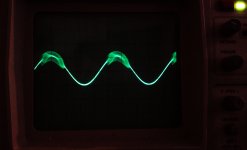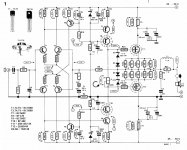Hi everyone.
I have built 2 times the Elektor mini-crescendo.Then one I am still using was built in 1986 and is still working.I use it very frequently but I was not aware for his instabilities because my interest turned to tubes.
After reading here about oscillations I checked out my amp. I attach a pic of my oscilloscope at 1khz.This is happening to channel (a) only and at mid-levels power output.At his maximum output the waveform is clean.The boucherot resistor is mildly hot but nothing of severe.
Is this the oscillation of crescendo you are are talking about?
Many thanks.Kris
I have built 2 times the Elektor mini-crescendo.Then one I am still using was built in 1986 and is still working.I use it very frequently but I was not aware for his instabilities because my interest turned to tubes.
After reading here about oscillations I checked out my amp. I attach a pic of my oscilloscope at 1khz.This is happening to channel (a) only and at mid-levels power output.At his maximum output the waveform is clean.The boucherot resistor is mildly hot but nothing of severe.
Is this the oscillation of crescendo you are are talking about?
Many thanks.Kris
Attachments
This amp rely on the mosfets input capacitance as a shunt compensation,
but since there s less output pairs than in the 140W crescendo, the circuit
is not well damped.
You should try to add two 10 to 22pF compensation caps, one from T9 base
to T10 collector and the other from T7 base to T8 collector.
Use preferably caps rated at least 300V, 500V being even better.
but since there s less output pairs than in the 140W crescendo, the circuit
is not well damped.
You should try to add two 10 to 22pF compensation caps, one from T9 base
to T10 collector and the other from T7 base to T8 collector.
Use preferably caps rated at least 300V, 500V being even better.
Before starting putting caps i checked the quiescent current and it was too high.After so many years I had never adjusted it.Now its clean from oscillations at all.The sine waveform is perfect but there is some rounding of square wave at 10 Khz though but I think many amps have. Anyway I want to thak you for your kind help.Regards.Kris
Hi,
changing the output bias is not curing the stability issue. You are just hiding it.
If you investigate more thoroughly you will find that the oscillation still exists.
I can only see the 330pf and the output Zobel as added stabilisation components.
I think Wahab could be right.
The stability needs to be improved. The easy way is adding Cdom.
changing the output bias is not curing the stability issue. You are just hiding it.
If you investigate more thoroughly you will find that the oscillation still exists.
I can only see the 330pf and the output Zobel as added stabilisation components.
I think Wahab could be right.
The stability needs to be improved. The easy way is adding Cdom.
just noticed the typical voltages around the input are wrong.
0V at the bases should be Rin * Ibupper-Iblower. Expect +-10mV to +-30mV for an imbalance of +-0.3uA to +-1uA of upper and lower base currents.
The +0V7 and -0V7 have been transposed. Expect +-0V8. R7/8 to T6 to be -0V8
0V at the bases should be Rin * Ibupper-Iblower. Expect +-10mV to +-30mV for an imbalance of +-0.3uA to +-1uA of upper and lower base currents.
The +0V7 and -0V7 have been transposed. Expect +-0V8. R7/8 to T6 to be -0V8
Last edited:
To be honest after the adjustment I didnt get better sound.In a tube amp in the past I had had similar oscillation but when I adjusted the bias that produced better sound.I'll check again.I have a question.Some people say here that mosfets oscillate in the MHz band.How do they investigate it? With a wider band oscilloscope? With FFT? I would like to learn more.This Crescendo is a good amp to learn things, a better name of his could be Tormento  )
)
The gate stopper (r23) should be mounted very close to the gate lead of the output mosFET. To reduce the inductance of the wire and lead even more the gate stopper can be soldered direct to the gate lead very close to the body of the FET.
This can reduce the total length of connection from~10mm to ~5mm. 20mm is a non starter (potential oscillator)
This can reduce the total length of connection from~10mm to ~5mm. 20mm is a non starter (potential oscillator)
180 w Oscillations
Hi
I have also a similar oscillations on my 180 W Crescendo which has paraller FETs at the output. There is an oscillation burst on the positive top when I turn upp the volume on the sine wave. At around +/- 20V at the output the HF bursts do start. The amplfier can also go easy into swinging mode without signal with around 4MHZ high output swing. Putting my finger close to the variable bias resistor can initate the oscillations. I have put 68 nf across the bias resistor and changed the source resistors to metal films without any change. Maybe I should 300 pf input capacitance to the SK135 between the G and the S ?
Any other suggestions ?
[image]
Hi
I have also a similar oscillations on my 180 W Crescendo which has paraller FETs at the output. There is an oscillation burst on the positive top when I turn upp the volume on the sine wave. At around +/- 20V at the output the HF bursts do start. The amplfier can also go easy into swinging mode without signal with around 4MHZ high output swing. Putting my finger close to the variable bias resistor can initate the oscillations. I have put 68 nf across the bias resistor and changed the source resistors to metal films without any change. Maybe I should 300 pf input capacitance to the SK135 between the G and the S ?
Any other suggestions ?
[image]
An externally hosted image should be here but it was not working when we last tested it.
[/image]Hi
I have also a similar oscillations on my 180 W Crescendo which has paraller FETs at the output. There is an oscillation burst on the positive top when I turn upp the volume on the sine wave. At around +/- 20V at the output the HF bursts do start. The amplfier can also go easy into swinging mode without signal with around 4MHZ high output swing. Putting my finger close to the variable bias resistor can initate the oscillations. I have put 68 nf across the bias resistor and changed the source resistors to metal films without any change. Maybe I should 300 pf input capacitance to the SK135 between the G and the S ?
As explained on the original article the amp compensation rely
on the fets input capacitances to providing a shunt compensation ,
an hazardous "solution" that will leave some builders chasing ghosts...
To be stable enough without relying on the said random parameters
two compensation caps , about 22pF each , should be implemented
from inputs to outputs of the cascodes.
I commented on this amp here on the forum a few years ago along the same lines as Wahab - that Crescendo is indeed a 'Tormento'.
Elektor have been notorius over the years for releasing designs that were marginal in terms of stability.
This amp is crying out (make that 'yelling') for some decent compensation - like Cdoms from the VAS cascode collectors to the bases of the VAS transistors.
I just did a quick calc and Wahab's proposal is a good one - it closes the loop gain at c. 1.5MHz (10pf) and about 750 kHz (22pF). With the current design it looks like the ULGF is very ill defined.
However, looking at your trace, if the oscillation is up at a few MHz, it could also mean you have output stage parasitic oscillation as well . . .
Elektor have been notorius over the years for releasing designs that were marginal in terms of stability.
This amp is crying out (make that 'yelling') for some decent compensation - like Cdoms from the VAS cascode collectors to the bases of the VAS transistors.
I just did a quick calc and Wahab's proposal is a good one - it closes the loop gain at c. 1.5MHz (10pf) and about 750 kHz (22pF). With the current design it looks like the ULGF is very ill defined.
However, looking at your trace, if the oscillation is up at a few MHz, it could also mean you have output stage parasitic oscillation as well . . .
Last edited:
Forget increasing the bias to a rediculous level, or doing injustice to the effective Ft by increasing the gate stopper. Just place a small zero from the gate to drain of the output mosfets right at the device pins. ~40pf in series with ~200R and solder it from gate to drain and that oscillation burst will go away for good.
- Status
- This old topic is closed. If you want to reopen this topic, contact a moderator using the "Report Post" button.
- Home
- Amplifiers
- Solid State
- Crescendo question

